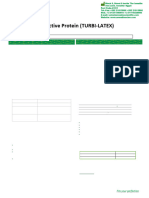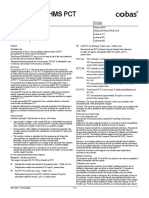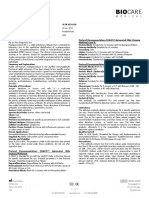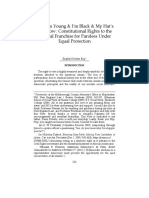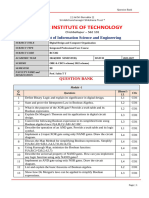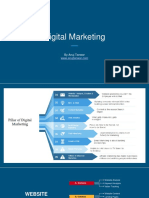PG Ii
Uploaded by
NIGHT tubePG Ii
Uploaded by
NIGHT tubePG II iFlash
Immunoassay Analyzer
Anti-Pepsinogen II acridinium-ester-labeled
REF C86041 2×50 Tests R2 conjugate; 4.0 mL/pack; 0.05% ProClin
300.
INTENDED USE Assay diluent, 4.0 mL/pack; 0.05% ProClin
R3
The iFlash-PG II assay is a paramagnetic particle 300.
chemiluminescent immunoassay (CLIA) for the
quantitative determination of Pepsinogen II in human Calibrator 1, 1 bottle, 1.0 mL, phosphate
serum and plasma using the iFlash Immunoassay CAL1 buffer with protein stabilizers, 0.05%
Analyzer. ProClin 300.
SUMMARY AND EXPLANATION
Calibrator 2, 1 bottle, 1.0 mL, Pepsinogen II
Pepsinogen II is produced by chief cells and mucous neck CAL2 in phosphate buffer with protein stabilizers,
cells of the gastric mucosa, in pyloric glands in the gastric 0.05% ProClin 300.
antrum, and Brunner’s glands in the proximal duodenum.
The ratio of concentration of Pepsinogen I (PG I) to PG II Calibrator 3, 1 bottle, 1.0 mL, Pepsinogen II
in plasma or serum of normal subjects is about 4:1. CAL3 in phosphate buffer with protein stabilizers,
0.05% ProClin 300.
PGs are released into the circulation and it is widely
accepted that serum PG level reflects the functional and
morphologic status of stomach mucosa. Human MATERIALS REQUIRED (BUT NOT PROVIDED)
pepsinogens have a diagnostic value for various REF C89999/C89959/C89949, iFlash Pre-Trigger
gastroduodenal disorders, especially for peptic ulcer, Solution: hydrogen peroxide solution.
atrophic gastritis and gastric cancer. The Pepsinogen I/ II REF C89998/ C89958/ C89948, iFlash Trigger Solution:
ratio can provide even better information on the extent of sodium hydroxide solution.
chronic gastritis. REF C89997, iFlash Wash Buffer: phosphate buffered
ASSAY PRINCIPLE saline solution with 0.05% ProClin 300.
The iFlash-PG II assay is a sandwich immunoassay. REF C80001, iFlash Wash Buffer (10×): phosphate
buffered saline solution with 0.05% ProClin 300.
st
1 incubation: Pepsinogen II in the sample,
anti-Pepsinogen II coated paramagnetic microparticles REF C89996, reaction vessels.
react to form a complex. Controls: Commercial controls could be used.
Wash: The unbound materials are washed away from WARNINGS AND PRECAUTIONS
the solid phase in a magnetic field.
IVD For in vitro diagnostic use
nd
2 incubation: Acridinium-ester-labeled anti-human
No known test method can offer the complete
Pepsinogen II antibody conjugate is added to form a
assurance that products derived from human sources
sandwich complex.
will not transmit infection. Therefore, all humanized
Another Wash. materials should be considered potentially infectious.
Trigger of signal: The Pre-Trigger and Trigger Exercise the normal precautions required for handling
Solutions are added to the reaction mixture. The all laboratory reagents.
resulting chemiluminescent reaction is measured as
Disposal of all waste material should be in accordance
relative light units (RLUs).
with local guidelines.
A direct relationship exists between the amount of
Wear gloves when handling specimens or reagents.
anti-Pepsinogen II in the sample and the RLUs
detected by the iFlash optical system. Clean and disinfect all spills of specimens or reagents
using a suitable disinfectant.
Results are determined via a calibration curve, which
is instrument-specifically generated by 3-point iFlash Trigger solution contains sodium hydroxide
calibration and a master curve provided via the (NaOH) and should be avoided contact with eyes.
reagent QR code.
REAGENT HANDLING
REAGENTS The reagents may not be used after the stated
Reagent kit, 100 tests, 2 packs, 50 tests/pack expiration date.
Anti-Pepsinogen II coated microparticles, Avoid the formation of foam with all reagents.
R1
3.5 mL/pack, 0.05% ProClin 300. The reagents in the pack and calibrators are ready for
use.
Close the bottles of calibrator right after calibration and
1/4 V2.0 English Ed.2018-02-01
PG II iFlash
Immunoassay Analyzer
store at 2–8°C. ASSAY PROCEDURE
Do not pool reagents within a reagent kit or between Refer to the system operating instruction or the online
reagent kits. help system for detailed information on preparing the
Prior to loading the iFlash-PG II reagent pack on the system.
system for the first time, suspend the microparticles by The test-specific parameters stored in barcode on the
inverting the reagent pack 30 times. reagent pack are read in. In case the barcode cannot
For further information on reagent handling be read, enter the sequence numbers.
precautions during system operation, refer to the Carry out calibration, if necessary.
iFlash system operating instruction. Place the calibrators CAL1, CAL2 and CAL3 in the
calibrator rack in the sample zone. Only keep
STORAGE AND STABILITY
calibrators open during calibration.
Storage: Test application.
Store at 2–8°C in an upright position. Load samples (Use 20 μL of sample for each
The kit may be used immediately after removal from determination in addition to the sample container and
2-8°C storage. system dead volumes).
Click RUN, the iFlash System performs all the
Stability:
functions automatically and calculates the results.
Unopened at 2–8°C: up to the stated expiration date.
Opened at 2–8°C: 28 days. CALIBRATION
Store on-board: 28 days. Traceability: This assay is traceable to commercial
reference serum.
SPECIMEN COLLECTION AND PREPARATION Every iFlash-PG II reagent kit has a QR code label
Serum or plasma (lithium heparin, sodium heparin containing the specific information for calibration of the
potassium EDTA, and sodium citrate) are the particular reagent lot.
recommended samples. Other anticoagulants have To perform an iFlash-PG II calibration, test CAL1,
not been validated for use with the iFlash-PG II assay. CAL2 and CAL3 in duplicate, and the predefined
Ensure that serum specimens to form complete clot master curve is adapted to the analyzer.
prior to centrifugation. Once an iFlash-PG II calibration is accepted and
Centrifuge the specimens. stored, all subsequent samples may be tested without
Store specimens at room temperature (20 to 25°C) for further calibration unless:
no longer than 8 hours. After 28 days when using the same reagent lot.
If the testing will not be completed within 8 hours, A reagent kit with a new lot number is used.
refrigerate the samples at 2 to 8°C. Controls are out of range.
If the testing will not be completed within 3 days, or for Required by pertinent regulations.
shipment of samples, freeze at -20°C or colder.
Frozen specimens must be mixed thoroughly after MEASURING RANGE
thawing. 0.50 – 150 ng/mL
The samples may be frozen for maximum 3 times. QUALITY CONTROL
Centrifuge specimens with a lipid layer on the top, and Quality control materials should be run as single
transfer only the clarified specimen without the lipemic determinations at least once every 24 hours when the test
material. is in use, once per reagent kit and after every calibration.
Ensure that residual fibrin and cellular matter have Include commercially available quality control materials
been removed prior to analysis. that cover at least two levels of analyte. Follow
Use with caution in handling patient specimens to manufacturer’s instructions for reconstitution and storage.
prevent cross-contamination. Each laboratory should establish mean values and
Do not use heat-inactivated samples. acceptable ranges to assure proper performance. Quality
control results that do not fall within acceptable ranges
Ensure that the patient samples, calibrators and
may indicate invalid test results.
controls are at ambient temperature (20–25°C) before
measurement. RESULT
Due to the possible evaporation, specimens and
Calculation:
calibrators on the analyzers should be measured
within 2 hours. The iFlash system automatically calculates the analyte
concentration of each sample. The results are given in
2/4 V2.0 English Ed.2018-02-01
PG II iFlash
Immunoassay Analyzer
ng/mL. Pepsinogen II reagents, samples and controls.
The within run precision was determined by testing each
Expected Values:
sample in replicates of 10 (n = 10), and calculating percent
A study of with iFlash-PG II assay on samples from 365 coefficient of variation (%CV). The results of the study are
apparently healthy people yielded the following result: shown below:
th th
<15 ng/mL, Pepsinogen I/Pepsinogen II > 3 (2.5 -95 Sample Mean (ng/mL) SD %CV
percentile)
It is recommended that each laboratory establish its own 1 4.82 0.19 3.98
expected reference range for the specific population.
2 14.50 0.58 3.97
LIMITATIONS
3 49.94 2.28 4.57
The iFlash-PG II assay is limited to the determination
of Pepsinogen II in human serum or plasma (lithium The between run precision was determined by testing
heparin, sodium heparin, potassium EDTA, and each sample in duplicate, two separate runs daily for 20
sodium citrate). It has not been validated for use with days (n = 80), and calculating percent coefficient of
other types of plasma. variation (%CV). The results of the study are shown
The use of serum separator (gel) blood collection below:
tubes has been validated for use with this assay. Sample Mean (ng/mL) SD %CV
However, it is not possible to survey all manufacturers
or tube types. 1 4.99 0.23 4.61
The upper limit of the measuring range of this assay is
2 49.14 2.58 5.24
150 ng/mL. Over-range samples may be diluted with
wash buffer recommended 1:5. Such as diluted by
hand, the result should be multiplied by the dilution Analytical Sensitivity
factor. If the machine is automatic dilution, the The detection limit representing the lowest measurable
machine will automatically calculate the results. The analyte level is 0.50 ng/mL, which can be distinguished
maximum dilution ratio of not less than 1:10. from zero. It is calculated as the value lying two standard
If the results are inconsistent with clinical evidence, deviations above that of the lowest standard of the master
additional testing is suggested to confirm the result. curve (standard 1 + 2 SD, n = 20).
For diagnostic purposes, the results should be Analytical Specificity
interpreted in light of the total clinical presentation of
The analytical specificity of iFlash-PG II assay was
the patient, including symptoms, clinical history results.
evaluated with analog into the negative sample.
Specimens from heparinized patients may be partially
Analog Acceptable
coagulated and erroneous results could occur due to Analog Assay result
concentration range
the presence of fibrin. name (ng/mL)
(ng/mL) (ng/mL)
The results from an alternative assays (i.e. EIA or RIA)
may not be equivalent and cannot be used Pepsinogen
200 < 0.5 0.03
interchangeably. Ⅰ
The assay is unaffected by icterus (bilirubin < 30
mg/dL), hemolysis (Hb < 1,500 mg/dL), lipemia Method Comparison
(Intralipid < 1,500 mg/dL) and total serum protein (< 10 A comparison of the iFlash-PG II assay (y) with a
g/dL). commercially available Pepsinogen II assay (x) using
No interference was observed from rheumatoid factors clinical samples was performed, and the curve is fitted
up to a concentration of 2,000 IU/mL. with Linear regression
No interference was observed from anti-nuclear y = 1.007x + 6.165
antibodies up to a concentration of 500 U/mL. r = 0.989
No interference was observed from HAMA up to a Sample concentration: 0.59 – 146.12 ng/mL
concentration of 600 ng/mL. Number of samples measured: 90
PERFORMANCE CHARACTERISTICS REFERENCES
Below are the representative performance data, and the 1. Kitahara F, Kobayashi K, Sato T, et al. Accuracy of
results obtained in individual laboratories may differ. screening for gastric cancer using serum pepsinogen
Precision concentrations. Gut. 1999; 44: 693-697.
The precision of iFlash-PG II was determined using 2. HHS Publication, 4th ed., May 1999. Biosafety in
3/4 V2.0 English Ed.2018-02-01
PG II iFlash
Immunoassay Analyzer
Microbiological and Biomedical Laboratories. ANNEX A:
Available. Explanation of abbreviation
3. Samloff IM, Varis K, Ihamaki T, et al. Relationships
Abbreviation Explanation
Among Pepsinogen I, Serum Pepsinogen II, and
Gastric Mucosal Histology. Gastroeneterology 1982;
83: 204-209. Product No.
4. Kikuchi S, Wade O, Miki K, et al.Serum Pepsinogens
as a Screening test of extensive chronic gastritis. Calibrator
Gastroenterologica Jpaonica.1987; 22 (2): 133-141.
5. Miki k, Oka H:Significance of determination of serum Reagent
pepsinogen. Naika 1986;58 (3): 716-718.
6. Oka H, Miki K, et al. Medical application of pepsinogen
Number of tests
RIA Kit. Rinho Seijinbyo 1989; 19 (4) 531-537.
7. Fujinaga M, Chernaia MM, Tarasova NI, Mosimann
SC, James MN. Crystal structure of human pepsin and Manufactured by
its complex with pepstatin. Protein Sci. 1995-05, 4 (5):
960–72. EU Representative
SHENZHEN YHLO BIOTECH CO., LTD. EC Declaration of Conformity
1st-4th Floor, No.5 Building, Lishan Industrial
Area, Xinghai Road, Nanshan District, Shenzhen Caution
518054, China
Instructions for use
Wellkang Ltd (www.CE-marking.eu) In vitro diagnostic medical
Suite B, 29 Harley St., London W1G 9QR, UK device
Lot No.
Date of manufacture
Expiry date
Biohazard Symbol
Pictograms for Caution
Pictograms for Hazardous to the
aquatic environment
4/4 V2.0 English Ed.2018-02-01
You might also like
- PI - BX-3010 Reagents Pre-Albumin FS - V1No ratings yetPI - BX-3010 Reagents Pre-Albumin FS - V12 pages
- Connecting Peptide (C-Peptide) CLIA: 2 X 50 Test 52025078No ratings yetConnecting Peptide (C-Peptide) CLIA: 2 X 50 Test 520250782 pages
- C86000 13.04.04.068305 iFlash-Total PSA CLIA V7.0 2020-04-07No ratings yetC86000 13.04.04.068305 iFlash-Total PSA CLIA V7.0 2020-04-074 pages
- Insert.Elecsys Anti-CCP.05031656500.V10.enNo ratings yetInsert.Elecsys Anti-CCP.05031656500.V10.en5 pages
- AI_AMPLIRUN INFLUENZA A H5 RNA CONTROL_MBC052_EN-23070No ratings yetAI_AMPLIRUN INFLUENZA A H5 RNA CONTROL_MBC052_EN-230702 pages
- Napsin A (MRQ-60) - CM - MAN - EN - IVD - 2.0No ratings yetNapsin A (MRQ-60) - CM - MAN - EN - IVD - 2.06 pages
- Insert - Elecsys Prolactin II.03203093500.V12.enNo ratings yetInsert - Elecsys Prolactin II.03203093500.V12.en5 pages
- Package Insert - 07325 - Prolactina - en - 30410 PDFNo ratings yetPackage Insert - 07325 - Prolactina - en - 30410 PDF7 pages
- PI - BX-3010 Reagents Apolipoprotein A1 FS - V2No ratings yetPI - BX-3010 Reagents Apolipoprotein A1 FS - V22 pages
- Lyphochek Immunology Plus Control Levels 1 and 2: 430 430X Bilevel Minipak 12 X 1 ML 2 X 1 ML Level 1 27551 Level 2 27552No ratings yetLyphochek Immunology Plus Control Levels 1 and 2: 430 430X Bilevel Minipak 12 X 1 ML 2 X 1 ML Level 1 27551 Level 2 275526 pages
- Ros1 (Epmghr2) : Available Product FormatsNo ratings yetRos1 (Epmghr2) : Available Product Formats2 pages
- Progesterone III: A) Tris (2,2'-Bipyridyl) Ruthenium (II) - Complex (Ru (Bpy) )No ratings yetProgesterone III: A) Tris (2,2'-Bipyridyl) Ruthenium (II) - Complex (Ru (Bpy) )4 pages
- Covid-19 Human Igm Igg Assay Kit: Catalog Number Ka5826 96 AssaysNo ratings yetCovid-19 Human Igm Igg Assay Kit: Catalog Number Ka5826 96 Assays9 pages
- Monoclonal ANTI-FLAG M2, Clone M2 (F3165) - Data Sheet100% (1)Monoclonal ANTI-FLAG M2, Clone M2 (F3165) - Data Sheet4 pages
- C86006 13.04.04.068904 iFlash-CA 15-3 CLIA V5.0 2020-04-07No ratings yetC86006 13.04.04.068904 iFlash-CA 15-3 CLIA V5.0 2020-04-074 pages
- PI - BX-3010 Reagents Antistreptolysin O FS - V2No ratings yetPI - BX-3010 Reagents Antistreptolysin O FS - V22 pages
- Insert - Elecsys CA 15-3 II.07027001500.V7.enNo ratings yetInsert - Elecsys CA 15-3 II.07027001500.V7.en5 pages
- 1 X 53/1 X 20 ML 12011027: Agappe Diagnostics LTDNo ratings yet1 X 53/1 X 20 ML 12011027: Agappe Diagnostics LTD1 page
- Qty Name Notes Form: Fungibacid 5Ml/ Nail SolutionNo ratings yetQty Name Notes Form: Fungibacid 5Ml/ Nail Solution1 page
- Circadian Rhythm: I. Basic of The Thyroid Function: Fundamentals in Laboratory MedicineNo ratings yetCircadian Rhythm: I. Basic of The Thyroid Function: Fundamentals in Laboratory Medicine6 pages
- Download Full (Ebook) Greek Sanctuaries and Temple Architecture: An Introduction by Mary Emerson ISBN 9781472575289, 1472575288 PDF All Chapters100% (5)Download Full (Ebook) Greek Sanctuaries and Temple Architecture: An Introduction by Mary Emerson ISBN 9781472575289, 1472575288 PDF All Chapters71 pages
- How To Overcome Your Fear of Public Speaking DR Aziz PDFNo ratings yetHow To Overcome Your Fear of Public Speaking DR Aziz PDF25 pages
- Immediate Download The Senses Classical and Contemporary Philosophical Perspectives 1st Edition Macpherson Ebooks 2024100% (8)Immediate Download The Senses Classical and Contemporary Philosophical Perspectives 1st Edition Macpherson Ebooks 202470 pages
- Cuz I'm Young & I'm Black & My Hat's Real Low: Constitutional Rights To The Political Franchise For Parolees Under Equal Protection by Shaylen Roberts, Esq.No ratings yetCuz I'm Young & I'm Black & My Hat's Real Low: Constitutional Rights To The Political Franchise For Parolees Under Equal Protection by Shaylen Roberts, Esq.33 pages
- Volunteering and Its Surprising BenefitsNo ratings yetVolunteering and Its Surprising Benefits8 pages
- 22 CSE III and IV Semester Scheme and SyllabusNo ratings yet22 CSE III and IV Semester Scheme and Syllabus67 pages
- SW450 Literature Review - Ashley SchultzNo ratings yetSW450 Literature Review - Ashley Schultz9 pages
- Economics 2019 v1.1: IA2 Sample Assessment InstrumentNo ratings yetEconomics 2019 v1.1: IA2 Sample Assessment Instrument6 pages
- Pillars OF Digital Marketing by Anuj TanwarNo ratings yetPillars OF Digital Marketing by Anuj Tanwar13 pages
- Primavera Training - V 16.1 BU - Sep 2016 PDFNo ratings yetPrimavera Training - V 16.1 BU - Sep 2016 PDF464 pages
- Connecting Peptide (C-Peptide) CLIA: 2 X 50 Test 52025078Connecting Peptide (C-Peptide) CLIA: 2 X 50 Test 52025078
- C86000 13.04.04.068305 iFlash-Total PSA CLIA V7.0 2020-04-07C86000 13.04.04.068305 iFlash-Total PSA CLIA V7.0 2020-04-07
- AI_AMPLIRUN INFLUENZA A H5 RNA CONTROL_MBC052_EN-23070AI_AMPLIRUN INFLUENZA A H5 RNA CONTROL_MBC052_EN-23070
- Package Insert - 07325 - Prolactina - en - 30410 PDFPackage Insert - 07325 - Prolactina - en - 30410 PDF
- Lyphochek Immunology Plus Control Levels 1 and 2: 430 430X Bilevel Minipak 12 X 1 ML 2 X 1 ML Level 1 27551 Level 2 27552Lyphochek Immunology Plus Control Levels 1 and 2: 430 430X Bilevel Minipak 12 X 1 ML 2 X 1 ML Level 1 27551 Level 2 27552
- Progesterone III: A) Tris (2,2'-Bipyridyl) Ruthenium (II) - Complex (Ru (Bpy) )Progesterone III: A) Tris (2,2'-Bipyridyl) Ruthenium (II) - Complex (Ru (Bpy) )
- Covid-19 Human Igm Igg Assay Kit: Catalog Number Ka5826 96 AssaysCovid-19 Human Igm Igg Assay Kit: Catalog Number Ka5826 96 Assays
- Monoclonal ANTI-FLAG M2, Clone M2 (F3165) - Data SheetMonoclonal ANTI-FLAG M2, Clone M2 (F3165) - Data Sheet
- C86006 13.04.04.068904 iFlash-CA 15-3 CLIA V5.0 2020-04-07C86006 13.04.04.068904 iFlash-CA 15-3 CLIA V5.0 2020-04-07
- Qty Name Notes Form: Fungibacid 5Ml/ Nail SolutionQty Name Notes Form: Fungibacid 5Ml/ Nail Solution
- Circadian Rhythm: I. Basic of The Thyroid Function: Fundamentals in Laboratory MedicineCircadian Rhythm: I. Basic of The Thyroid Function: Fundamentals in Laboratory Medicine
- Download Full (Ebook) Greek Sanctuaries and Temple Architecture: An Introduction by Mary Emerson ISBN 9781472575289, 1472575288 PDF All ChaptersDownload Full (Ebook) Greek Sanctuaries and Temple Architecture: An Introduction by Mary Emerson ISBN 9781472575289, 1472575288 PDF All Chapters
- How To Overcome Your Fear of Public Speaking DR Aziz PDFHow To Overcome Your Fear of Public Speaking DR Aziz PDF
- Immediate Download The Senses Classical and Contemporary Philosophical Perspectives 1st Edition Macpherson Ebooks 2024Immediate Download The Senses Classical and Contemporary Philosophical Perspectives 1st Edition Macpherson Ebooks 2024
- Cuz I'm Young & I'm Black & My Hat's Real Low: Constitutional Rights To The Political Franchise For Parolees Under Equal Protection by Shaylen Roberts, Esq.Cuz I'm Young & I'm Black & My Hat's Real Low: Constitutional Rights To The Political Franchise For Parolees Under Equal Protection by Shaylen Roberts, Esq.
- Economics 2019 v1.1: IA2 Sample Assessment InstrumentEconomics 2019 v1.1: IA2 Sample Assessment Instrument

















